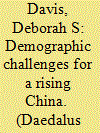| Srl | Item |
| 1 |
ID:
130391


|
|
|
|
|
| Publication |
2014.
|
| Summary/Abstract |
Looking into the near future, China faces immense demographic challenges. Prolonged sub-replacement fertility has created irreversible conditions for rapid aging of the population, and massive migration to cities has left many villages populated by elderly farmers with no adult children to support them. Soaring divorce rates and high levels of residential dislocation have eroded family stability. To a large extent, government policies created to accelerate economic growth inadvertently fostered these demographic challenges, and now the country is facing the negative consequences of interventions that previously spurred double-digit growth. Legacies of Confucian familism initially blunted pressures on families. Filial sons and daughters sent back remittances, parents cared for migrants' children and invested in their children's marriages, and families with four grandparents, two parents, and one child (4+2+1) pooled resources to continuously improve a family's material well-being. But now the demographic challenges have further intensified and the question arises: can the state adopt new policies that will allow the prototypical 4+2+1 families created by the one-child policy to thrive through 2030?
|
|
|
|
|
|
|
|
|
|
|
|
|
|
|
|
| 2 |
ID:
141106


|
|
|
|
|
| Summary/Abstract |
Using a 2011 national survey of urban residents, irrespective of their official hukou status, and the 2000–2009 night-time light data from the Defense Meteorological Satellite Program Operational Linescan System (DMSP-OLS), this paper goes beyond the simple dichotomy of migrant versus non-migrant or rural versus urban hukou to disentangle the processes of urbanization and migration and their complex associations with health, and assesses the impact of various levels and speed of urbanization on the physical and mental health of current residents in a city or town. By disaggregating urbanization into three discrete dimensions at sub-provincial levels, we find that while a higher absolute level of urbanization at the county level negatively impacted self-reported physical health, faster and accelerating urbanization had a positive impact which could be attributed to the demand-pull effect underlying the healthy migrant phenomenon. By contrast, all three dimensions of urbanization were associated with greater depressive distress and thus had an adverse effect on residents' mental health. Beyond demonstrating how variation in the process and location of urbanization affects individual health, we also illustrate more broadly the value of modelling locational parameters in analyses of individual outcomes based on national samples.
|
|
|
|
|
|
|
|
|
|
|
|
|
|
|
|